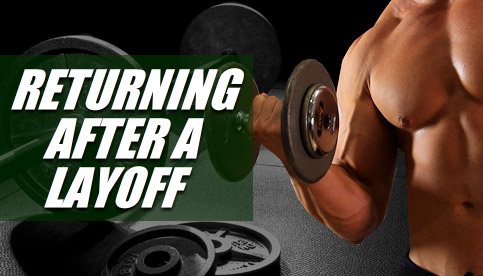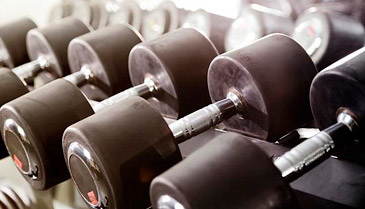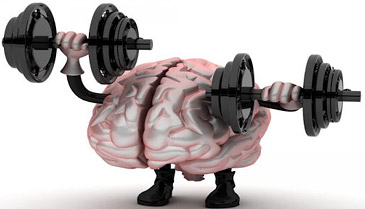HOW TO RETURN TO THE GYM AFTER A TRAINING LAYOFF

If you’re training hard in the gym as part of a regular ongoing lifestyle, it’s a virtual guarantee that you’ll encounter temporary periods every so often where your workout plan needs to be put on hold.
Maybe you’ve come down with an illness or an injury that needs to heal…
Maybe work or school has gotten particularly busy and you need time away to place your focus there…
Or maybe you’re simply experiencing a dip in your motivation levels and feel the need to rest and re-charge before returning back to your regular routine.
Whatever the case may be, here are the simple steps you’ll want to follow so that you can safely return to the gym after a training layoff and get back on track as efficiently as possible…
Step #1 – Recognize That It’s Nothing To Stress Out About

Fitness is not some sort of temporary “quick fix”; it’s a life-long pursuit.
For that reason, it’s what you do in the big picture that truly counts.
Your muscle building, fat burning and strength gaining progress will never be perfectly linear, and there are bound to be bumps in the road along the way that cause your gains to temporarily regress.
This is completely normal and happens to every single lifter out there regardless of their experience level or how diligent they are with their training and nutrition.
So, if the time has come to return to the gym after a layoff, the first step is simply to acknowledge that this is an inevitable part of the process, and that short term breaks are no big deal in the long run.
Significant losses in muscle size and strength take quite a bit longer to truly kick in than most people think, and temporary layoffs of around 2-6 weeks are usually not going to be lengthy enough to cause any serious overall damage.
Recognizing this fact will prevent you from getting discouraged so that you can maintain the focus and motivation you’ll need moving forward.
Step #2 – Assess The Current Situation

Exactly how much muscle mass and strength you lost during your gym layoff will depend on many different factors, including how long the break was, what your diet was like, your sleeping habits, as well as your overall lifestyle in general.
For example, if you were only away from the gym for 2 weeks and were eating and sleeping reasonably well during that time, you probably didn’t lose any actual lean muscle at all and may only experience a very small decrease in strength when you return to lifting.
On the other hand, if your training layoff lasted for 6 full weeks and was accompanied by a calorie deficit, poor sleeping patterns and high amounts of daily stress, the effects would obviously be much more significant.
Sit down and take all of these factors into account, and then treat your first few sessions back in the gym as “test workouts” to see where your strength levels are currently at.
Step #3 – Take Your Time And Don’t Try To Rush The Process

The biggest mistake most trainees make when they come back to the gym after a layoff is that they try to immediately pick up right where they left off.
Yes, having to drop the weights back down from your previous numbers may feel a bit discouraging, but it’s critical that you leave your ego at the door and give yourself adequate time to properly re-build your strength.
There’s no way to know exactly how much weight you’ll be capable of lifting when you first return to the gym, so you’ll simply need to experiment and go by feel.
If in doubt, always err on the side of caution and go a bit lighter rather than heavier, because even if you do select a weight that is too light you can simply increase the rep range to compensate.
If you get over confident and try to handle a weight that is too heavy for you right from the get go, you could easily end up injuring yourself, which is the absolute last thing you need when you’re just getting back into training.
This is especially true if your layoff was due to an injury, in which case you’ll want to be extra cautious to ensure that you’ve truly healed and to re-acclimate your joints and connective tissues to progressively heavier training.
In any case, start out on the lighter end with higher reps to gradually get a feel for things, and within a few sets of each lift you should have a pretty good idea of where your strength currently stands.
Once you’ve established your starting numbers, aim for standard progressive overload from that point forward just as you normally would.
A lot of lifters will try to rush things as a way of getting back to their previous shape by increasing their training intensity, performing additional volume or inserting extra workouts in during the week.
In reality, this is completely unnecessary and will only increase the chances of burn out, excessive soreness and injury.
It’s crucial that you accept your current size and strength for what it is and simply move forward from that point in the same way you normally would.
Step #4 – Be Thankful For The Benefits Of “Muscle Memory”

Not only will a short gym layoff typically only have a modest impact on your overall progress, but whatever size and strength you did happen to lose during that time will almost always come back at a much faster pace than it took to originally build it.
This effect is known as “muscle memory”, and anyone who has taken time off from the gym and then returned to consistent training can attest to it.
The body never truly “forgets” those initial adaptations that were made from previous periods of training, and once you begin hitting the weights again, they’ll kick back into gear and rebuild whatever gains were lost fairly quickly.
Also keep in mind that what often appears to be muscle loss during a gym layoff isn’t even primarily the result of actual reductions in lean muscle tissue itself.
Instead, it’s simply being caused by decreases in the amount of fluid and glycogen that are stored in the muscle cell due to inactivity.
You’ll often notice that your physique begins to “flatten out” after a couple weeks away from the gym and loses some of its visible muscle definition, but within a fairly short period of proper training and nutrition that fullness and separation will come back.
Don’t discount the psychological side either, as our mind will often play tricks on us during a training layoff and lead us to believe that we look much smaller and weaker than we actually are.
Not only will your previous muscle size come back quite quickly once you return to the gym, but your strength levels typically will as well.
Remember that your ability to lift those heavy weights in the gym is not only a product of actual muscular strength, but it’s also a learned motor skill.
While losses in lean muscle may play a contributing role in your reduced levels of strength after a layoff, neurological adaptations are actually the primary cause most of the time.
In other words, your body has simply become less efficient at each specific movement pattern since you haven’t been regularly performing them like you normally do.
Once you get back into the gym consistently, your body will quickly re-learn those movements and your weights on each exercise will begin shooting back up at a reasonably quick pace.
Returning To The Gym After A Layoff: The Bottom Line

When it all comes down to it, there really isn’t anything fancy that you need to do when it comes to getting back on track after a training break…
1) Recognize that layoffs are a completely normal and inevitable part of training so that you don’t get discouraged and so that you can maintain your focus moving forward.
2) Start off using lighter weights for higher reps during your first few sessions to get a feel for your current strength levels.
3) Once you’ve established your starting weights, apply gradual progressive overload in the same way you normally would without trying to rush the process or unnecessarily modifying your routine.
4) Keep in mind that significant losses in muscle size and strength take quite a while to kick in, and that whatever gains you did lose during your layoff will come back quite quickly due to the effects of muscle memory.
Apply these simple steps, stay consistent, and you’ll be right back to where you were and progressing even further before you know it.
If you found this article helpful, make sure to sign up for your FREE custom fitness plan below...




